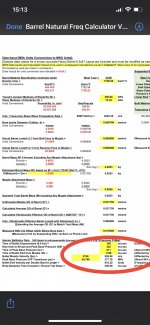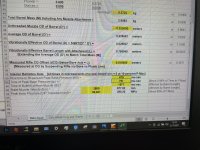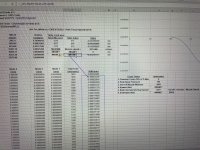Jim - Has anyone tested your bullet designs from a structured barrel? From what I've read they eliminate tune sensitivity better than any other method I've seen.
Hopefully the below will be somewhat coherent. I'm tired, been a long week. This may apply to what your chasing. The layout would likley need to change to accommodate a muzzle break, but the concept could apply.
I'm very curious to get your thoughts on a different approach to a tuner I've been working on. It's more of a hybrid dampener tuner.
The adjustable muzzle mass sleeve's the barrel with an o-ring array between the sleeve and the barrel. So far it has produced positive results on target on my otherwise stock B14R rim-fire test platform. Best 5 shot groups @ 100y were .183 with Eley 10x & .182 with with SK LR match. That was with a bi-pod + rear squeeze bag. Those best to date results were with 3 of 5 possible o-rings installed in the front, center, and back positions. I did shoot the same lots of ammo with bare muzzle and although I cant quantify exactly, the improvement was very apparent. Since I don't have a labradar I'll be extending one of the front stock mounted weight rods to mount my Magneto speed to.
I'm about to start testing with all 5 o-rings installed & thus far have only tested 70 durometer o-rings. The current design (version #2) is using large coarse threads on the sleeve - muzzle adapter & it is the o-ring compression that prevents it from spinning. The idea is to allow the sleeve/mass to float on the o-rings via the coarse threads.
The # of possible tuning variables is well a lot! O-ring durometer, Qty, spacing, compression, location from muzzle, & mass weight.
I'm really think this approach has merit, however I've never found any documentation for previous work on this. Everything I can find on the subject is either for traditional mass tuners or a big rubber doughnut type dampener. Never both combined.
I'm working on a version 3 that would allow the sleeve to truly float.
Someone such as yourself with your engineering and math knowledge could probably make much better progress in figuring out at least the baseline starting point for the many variables. Hell even If I manage to get this dialed in pretty well on the rim-fire, it'll be back to square 1 when switching to CF.
Pic's below are current Version #2
muzzle thread adapter with smooth i.d.
View attachment 7704743
View attachment 7704745
Sleeve/mass with o-rings. o-ring groove depth in sleeve adjusted for barrel taper to give same compression on all 5 o-rings. Compression could be varied ring- ring giving another tuning option.
View attachment 7704746
installed.
View attachment 7704747




